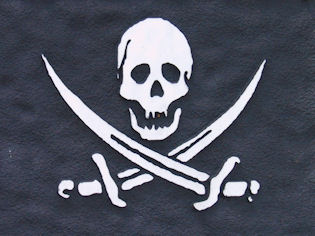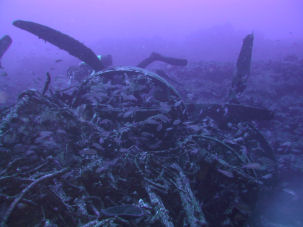von Roger Blum
Curious Nature:
Jellyfish in Fresh Water?
They’re down there, beneath the surface, pulsating gently like so many translucent hearts. Only they have tentacles. And toxic barbs.
|
|
I could not believe what I saw during the last dive. A softbodied, free-swimming aquatic animal with a gelatinous umbrella-shaped bell and trailing tentacles. Jellyfish are usually known to be found in the salty seas, so finding them in fresh water lakes in Germany is a bit of surprise. Are jellyfish spreaded in european freshwater lakes?
|
|
Yes and no. The freshwater jellies with the scientific name Craspedacusta sowerbii are looking like jellyfishes, but they are not true jellyfishes as are some of its marine relatives. They differ slightly from the true marine jellyfish. Scyphozoan jellyfish are exclusively marine, but some hydromedusan jellyfish live in freshwater. Hydrozoans such as C. sowerbii differ from Scyphozoans because they have a muscular, shelf-like structure called a velum on the ventral surface, attached to the bell margin.
|
|
However, because Craspedacusta sowerbii looks like a jellyfish, we call it a jellyfish! The bell (body) of the jellyfish is up to 25 mm in diameter. They have a whorl of up to 600 tentacles tightly packed around the bell margin. The tentacles contain hundreds of special cells called cnidocytes. The cnidocytes contain the nematocysts that are used to capture prey.
|
|
They are most often found in calm, freshwater lakes, reservoirs and water-filled gravel pits or quarries. The jellyfish prefer standing water rather than currents. So, they generally are not seen in fast flowing streams or rivers.
|
|
Sightings of the small, umbrella-shaped creatures, an invasive species, aren't as rare as you might think
|
|
Craspedacusta sowerbii has spread from its home range in the Yangtze valley in China, reaching all temperate continents during the twentieth century. The only continent where not found is Antarctica.
|
|
The first record of the freshwater jellyfish Craspedacusta sowerbii in Germany was in a Gravel pit near Lohr/Aschaffenburg (Bavaria) in 1923. Yet just a short time later, the species was found in Finow canal in Brandenburg (1931), Volksgartenweiher in Cologne (1931), Lake Westhafen near Frankfurt a. M. (1932) and Quarry ponds near Schweinfurt in 1940. Within a few decades of the first discovery of C. sowerbii in Germany observations in more than 100 lakes were reported. Most of the lakes are artificial bodies of water such as quarry ponds, ponds or gravel pits. Distribution ranges are Pond Luberweiher in Regensburg, Quarry pond near Ingolstadt and Aschaffenburg in Bavaria, Quarry pond Epple near Karlsruhe in Baden-Wuerttemberg, Lake Niederweimar in Thuringia, the Quarry ponds I, II and III in Loebejuen near Halle (Saale), Lake Wehrstaedter and Lake Belicker near Magdeburg, Lake Dagow in Brandenburg and Lake Wannsee in Berlin.
|
 |
|
|
Freshwater jellyfish — forms of hydrozoa called Craspedacusta sowerbyi — are surprising divers in Quarry pond III in Loebejuen (Saxony-Anhalt)
|
|
Craspedacusta sowerbii is one of the few freshwater cnidarians with a pelagic life-stage. Medusae can occur at high abundance over several consecutive years, but may then be absent for several years subsequently. In Quarry ponds in Loebejuen, they can be observe in autumn regularly.
|
|
|
Das könnte Sie auch interessieren:
|

About Silver ships and pirate treasure (Wreck Diving)
Piraaaateeeeees!!! Once, this scream was more dreaded by sailors than hurricanes or scurvy. In the so-called ‘Golden Age of Piracy’ the Caribbean Sea became a major center of piracy in the 17th century. Numerous fortresses were built, cannonballs were fired, galleons full of treasure have sunk, it was a time of looting and robbery. During this period, some of the greatest buccaneers such as Henry Morgan, Kidd Blackbeard, L'Ollonais, Anny Bonny and Mary Reade launched their attacks against colonial naval vessels in Caribbean waters and became a part of history. These were crazy decades. During these decades many mad types emerged, who you can see in adventure books and movies today, such as scarred daredevils with a parrot on shoulder, eye-patch and curved cutlass in the belt. Whenever I went ashore during my journey through the Caribbean in April, I heard stories about sunken Galleons and legendary pirate treasure buried in Caribbean islands…
[mehr]
|
|

Kas Plane Wreck (Airplane wrecks)
A Italian three-engined bombardment plane is lying in the azure depths of Kas. The wreck is located near Flying fish reef in Turkish Waters near Meis Island at a depth of between 58 and 71 meters. The plane lies still complete except her motors but because of the time, her body is getting damaged and her skeleton can be seen. The airplane is a Savoia Marchetti SM 79 I "Sparviero" (Sparrowhawk) and many regarded it as one of the most succesfull hunter-torpedo-bombers of the World War II. It held a number of airspeed records since it first flew in September 1935 and had damaged a lot of allied ships by the deployment of its torpedo bombs in the Mediterranian and Aegean Sea. Taking off from the Greek islands controlled by the Axis states, the warbirds raided the eastern part of the Mediterranean. It seems that the particular plane was took off from an air base in Rhodes in 1941 with the assignment to bombard the Bristish warships inside the Meis harbour.
[mehr]
|
|
|
|


